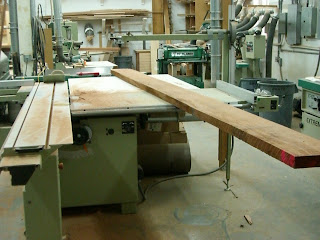
The inside of the sheer at the bow was routed and cut away to accept the breast hook.

When epoxied in place this 6 layers of 1/4" plywood, glued over a curved form to match the deck camber, adds great strength and rigidity.

The Sampson posts also needed to be securely attached to the inner bow stem. Of course, a pretty laminated piece was created.

African mahogany solid stock was used for laminating the deck frames. We liked the color and durability.

1/4" strips were ripped from the 2" thick plank.

A whole bunch of strips....

As the actual arc of the deck does not change from stem to stern, the frames could be glued up on jigs. The jigs were created by screwing angle iron on to the old lofting table.

After the epoxy cured, the sides of the frames were cleaned up with the planer.

A dove tail joint was needed where a frame intersected another frame. At the sheer, the frames were fitted into slots, every 9".

A simple jig worked for routing the edges of each dovetail.

Then a dovetail saw was used to make the angled lower cut.

This leaves the dove tail.

The lower edge is rounded to fit snugly into the receiving hole.

A receiving hole was mortised into the other frame.

These are the slots that were cut by hand into the sheer. They are every 9", and no jig could be used since they aren't square to the sheer. The angle changes slightly as the sheer rises toward the bow.

Each frame was marked, cut to length, and each end joint appropriately shaped depending on its placement. It was then sanded and epoxied with numerous coats.
Richard brainstormed about how to shape the carlins, the fore and aft side frames of the cabin. We wanted a curved cabin side, and it also needed to follow the rise of the sheer. He decided to use the actual sheer of the hull as the jig.

He needed assistance from Quinn to handle the long pieces and the clamping in a timely manner. Epoxy was applied to all strips.

Rolls of wrap were used to loosely hold the strips together.

Starting at the center and working toward the ends, there was still enough room for movement of the strips as the bundle was bent and then clamped.
Off to the jig (the hull).
The outside of the sheer had been covered with clear plastic to keep the frame from sticking to the hull. The top was covered with blue painters tape. The plastic wrap around the bundle was left in place during the drying.....
The bundle was roughly positioned and clamped in place.

Then the bundle was tightly clamped in the exact position, starting from the center out.

Wooden blocks were used to align the strips with themselves and create a solid frame.

Can never have too many clamps in a boat building project ....

The carlins are allowed to dry on each side of the jig (hull).

After several days the clamps can be removed.
During winter in Montana, even with a well insulated shop, the temperature in the shop has to be kept moderate. Even though the temptation is to crank the heat and dry the epoxy faster, we don't want all our boat bucks to go to the propane company.

The athwartship frames were placed so that the carlins could be set on them and moved around to determine the cabin shape.

Since we plan to live aboard, we decided to go with a full length cabin versus the slightly more traditional split cabin. As we age, we decided that ducking down for about 3 feet to move from the saloon to the forward head/dressing/work area was going to get increasingly difficult. The central bulkhead and door will ultimately be raised to the height of the cabin. Since we were deviating from the drawn plans we needed to determine a pleasing cabin length and side deck size.

We placed one extra athwartship long frame over where the head will be placed, to make a slightly longer foredeck. At this point we could actually stand in the boat and feel the size of the cabin.
We played with moving the front of the carlins closer together and further apart. This altered the side deck width and also the visual lines of the cabin. It's all about the look.....it is a traditional looking wooden boat, after all....
A slight narrowing of the cabin at the bow seemed to give the nicest look.Note the Sampson posts sticking up through the foredeck. They are only temporary, and Richard plans to replace them with white oak.

We settled on about a 22" finished side deck size. The carlins and the small side frames were dovetailed and fitted.











No comments:
Post a Comment